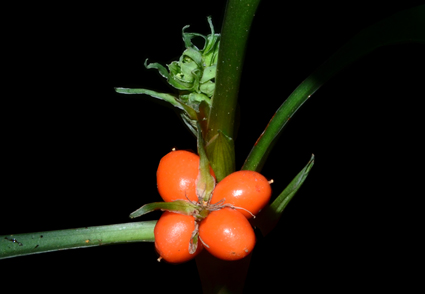Abstract
Rohdea wattii (C.B. Clarke) Yamashita & M.N. Tamura is a subtropical Asiatic species rediscovered after the type collection with a gap of 137 years from Manipur, India. Detailed taxonomic description, color plate, ecology, and nomenclature notes have been provided for this potential economically valuable wild ornamental species. Lectotype for the name R. wattii (≡Campylandra wattii C.B. Clarke) is designated here.
References
- Angiosperm Phylogeny Group (2016) An update of the Angiosperm Phylogeny Group classification for the orders and families of flowering plants: APG IV. Botanical Journal of the Linnean Society 181 (1): 1–20. https://doi.org/10.1111/boj.12385
- Baker, J.G. (1875) Revision of the Genera and Species of Asparagaceae. Journal of the Linnean Society, Botany 14: 508–632. [https://www.biodiversitylibrary.org/page/238351#page/588/mode/1up]
- Clarke, C.B. (1890) On the plants of Kohima and Muneypore. Botanical Journal of the Linnean Society 25: 1–106. https://doi.org/10.1111/j.1095-8339.1889.tb00793.x
- Feng, H.Z., Tong, Y., Wu, L., Gong, Y.N. & Liao, W.B. (2023) Rohdea brachyanthera (Asparagaceae), a new species from Guangdong, southern China. Phytotaxa 626 (1): 60–66. https://doi.org/10.11646/phytotaxa.626.1.7
- Gogoi, R. & Dasgupta, S. (2020) Asparagaceae In: Mao, A.A. & Dash, S.S. (Eds.) Flowering Plants of India, An annotated Checklist (Monocotyledons). Botanical Survey of India, Kolkata, pp. 199–200.
- Hooker, J.D. (1892) Flora of British India 6 (part 18). L. Reeve & Co., London, pp. 225–448.
- Hooker, J.D. (1894) Liliaceae. In: Hooker, J.D. (Ed.) The Flora of British India, Vol. 6. Reeve & Co., London, pp. 324–325.
- IUCN, 2022. Guidelines for using the IUCN Red List Categories and Criteria. Version 15.1. Prepared by the Standards and Petitions Committee. Available from: https://nc.iucnredlist.org/redlist/content/attachment_files/RedListGuidelines.pdf (Accessed: 11 October 2023).
- Ker Gawler, J.B. (1814) Tupistra squalida. Curtis’s Botanical Magazine 40: 1655
- Mabberley, D.J. (2018) Mabberley’s Plant-Book: A portable dictionary of plants, their classification and uses. 4th Edition. Cambridge University Press, Cambridge, 800 pp. https://doi.org/10.1017/9781316335581
- Odyuo, N., Roy, D.K. & Averyanov, L.V. (2017) Rohdea extrorsandra (Asparagaceae), a new species from northeastern India. Phytotaxa 309 (3): 283–287. https://doi.org/10.11646/phytotaxa.309.3.11
- Rafinesque, C.S. (1838) Tilcusta. In: Probasco, H. (Ed.) Flora Telluriana, Vol. 4. H. Probasco, No. 119, N. Fouth St., Philadelphia, pp. 1–15.
- Roth, A.G. (1821) Novae Plantarum Species Praesertim Indiae Orientalis. H. Vogleri, Halberstadii, pp. 196–197. [https://www.biodiversitylibrary.org/page/11163209#page/200/mode/1up]
- Songyun, L. & Tamura, M.N. (2000) Campylandra. In: Wu, Z.Y. & Raven, P.H. (Eds.) Flora of China. Vol. 24. Missouri Botanical Garden, St. Louis & Sciences Press, Beijing, pp. 235–239.
- Tanaka, N. (2003) New combinations in Rohdea (Convallariaceae). Novon 13: 329–333. https://doi.org/10.2307/3393269
- Tanaka, N. (2010) A taxonomic revision of the genus Rohdea (Asparagaceae). Makinoa N.S. 9: 1–54.
- Thunberg, C.P. (1784) Flora Japonica. J.G. Mülleriano, Lipsiae, 340 pp.
- Turland, N.J., Wiersema, J.H., Barrie, F.R., Greuter, W., Hawksworth, D.L., Herendeen, P.S., Knapp, S., Kusber, W.H., Li, D.Z., Marhold, K., May, T.W., Mcneill, J., Monro, A.M., Prado, J., Price, M.J. & Smith, G.F. (Eds.) (2018) International Code of Nomenclature for algae, fungi, and plants (Shenzhen Code) adopted by the Nineteenth International Botanical Congress Shenzhen, China, July 2017. Regnum Vegetabile 159. Volume 38. Koeltz Botanical Books, Glashütten. https://doi.org/10.12705/Code.2018
- Yamashita, J. & Tamura, M.N. (2004) Phylogenetic analyses and chromosome evolution in Convallarieae (Ruscaceae sensu lato), with some taxonomic treatments. Journal of Plant Research 117: 363–370. https://doi.org/10.1007/s10265-004-0169-z


